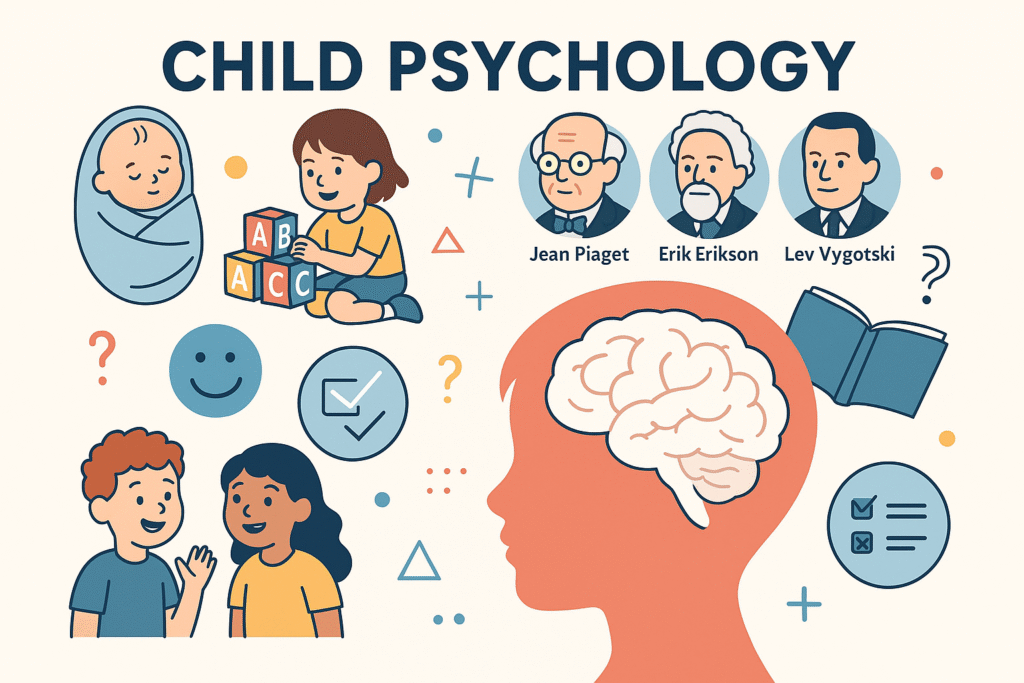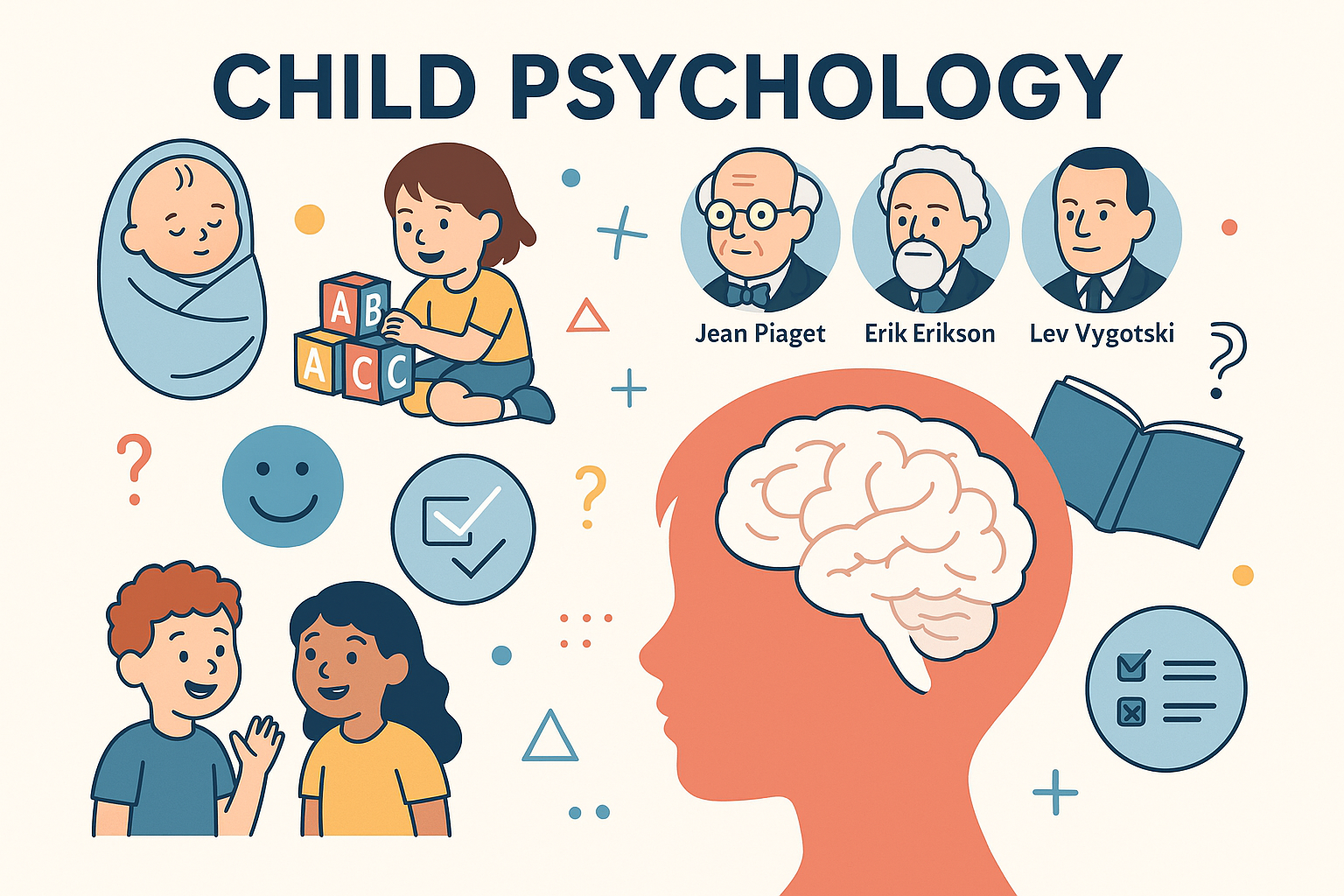
Child psychology is a crucial branch of psychology focused on the mental, emotional, and behavioral development of children from birth through adolescence. Understanding the psychological growth of children is vital for parents, educators, and professionals who influence the upbringing and education of young individuals. This article explores the primary developmental stages in child psychology, influential theories that shape our understanding of development, practical applications for supporting children, and the impact of environmental and cultural factors.
Developmental Stages in Child Psychology
1. Infancy (Birth to 2 Years)
Infancy is a period of rapid growth and foundational development. Psychologically, infants begin to form attachments, develop trust, and start exploring the world through sensory and motor experiences.
Key Milestones:
- Emotional bonding with caregivers (attachment)
- Development of trust versus mistrust (Erikson)
- Beginning of language acquisition
- Sensory-motor exploration (Piaget’s Sensorimotor Stage)
Cognitive Development:
- Object permanence
- Recognition of familiar faces
Social and Emotional Development:
- Expression of basic emotions (joy, anger, fear)
- Social smile, stranger anxiety
- Formation of secure/insecure attachment styles
2. Early Childhood (2 to 6 Years)
This stage is characterized by burgeoning independence, language development, and the beginning of logical thought.
Key Milestones:
- Rapid language acquisition
- Development of self-concept
- Learning through play
Cognitive Development:
- Symbolic thinking (Piaget’s Preoperational Stage)
- Egocentrism
- Beginning of imagination and pretend play
Social and Emotional Development:
- Increased interaction with peers
- Understanding emotions in self and others
- Development of empathy and moral reasoning
3. Middle Childhood (6 to 12 Years)
This is a time of increased cognitive, emotional, and social maturity. Children start formal schooling, develop friendships, and form a more accurate self-image.
Key Milestones:
- Mastery of reading, writing, and arithmetic
- Growth in logical and operational thinking
- Engagement in group activities and teamwork
Cognitive Development:
- Concrete operational thinking (Piaget)
- Improved memory and problem-solving skills
- Understanding of rules and fairness
Social and Emotional Development:
- Development of self-esteem
- Peer relationships become more complex
- Recognition of societal roles and norms
4. Adolescence (13 to 18 Years)
Adolescence is marked by identity formation, emotional fluctuations, and an increased capacity for abstract thought.
Key Milestones:
- Puberty and physical changes
- Search for identity (Erikson’s Identity vs. Role Confusion)
- Heightened self-awareness
Cognitive Development:
- Formal operational thought (Piaget)
- Abstract reasoning and hypothetical thinking
- Moral reasoning (Kohlberg)
Social and Emotional Development:
- Desire for autonomy
- Formation of intimate relationships
- Emotional regulation and identity exploration
Influential Theories in Child Psychology
Jean Piaget’s Cognitive Development Theory
Piaget proposed that children move through four stages of cognitive development:
- Sensorimotor Stage (Birth-2): Learning through sensory and motor interaction.
- Preoperational Stage (2-7): Development of language and symbolic thinking.
- Concrete Operational Stage (7-11): Logical thinking about concrete events.
- Formal Operational Stage (12+): Abstract and moral reasoning.
Significance: Piaget highlighted that children think differently from adults and that cognitive development occurs in a predictable sequence.
Erik Erikson’s Psychosocial Development Theory
Erikson emphasized psychosocial challenges at each life stage:
- Trust vs. Mistrust (0-1 year)
- Autonomy vs. Shame (1-3 years)
- Initiative vs. Guilt (3-6 years)
- Industry vs. Inferiority (6-12 years)
- Identity vs. Role Confusion (12-18 years)
Significance: Erikson’s theory connects emotional and social development, stressing the importance of resolving conflicts at each stage for healthy personality development.
Lev Vygotsky’s Sociocultural Theory
Vygotsky focused on the social and cultural influences on development. His concept of the Zone of Proximal Development (ZPD) illustrates how children learn best with guidance and social interaction.
Significance: Vygotsky’s theory emphasizes the role of language, social interaction, and cultural tools in shaping cognitive development.
Practical Applications for Parents and Educators
Supporting Development in Infancy
- Provide consistent, loving care to build trust.
- Engage in responsive interactions (e.g., cooing, smiling).
- Offer safe environments for sensory exploration.
Supporting Early Childhood
- Encourage imaginative play and storytelling.
- Use positive reinforcement to guide behavior.
- Introduce structured routines for stability.
Supporting Middle Childhood
- Foster problem-solving and critical thinking through games and discussions.
- Promote collaboration through group projects.
- Reinforce effort and persistence to build self-esteem.
Supporting Adolescents
- Respect their need for autonomy while setting clear boundaries.
- Engage in open conversations about identity, values, and emotions.
- Encourage participation in extracurricular activities to explore interests.
Creating a Positive Learning Environment
- Ensure emotional safety and mutual respect.
- Differentiate instruction to meet diverse learning needs.
- Provide opportunities for cooperative learning and peer interaction.
Promoting Social Skills
- Model respectful and empathetic behavior.
- Teach conflict-resolution strategies.
- Encourage inclusive activities that build teamwork.
Supporting Emotional Well-being
- Validate children’s feelings and encourage expression.
- Teach coping strategies like deep breathing or journaling.
- Seek professional support if emotional difficulties persist.
Addressing Common Psychological Challenges
Anxiety
- Common in school-aged children and adolescents.
- Signs: Excessive worry, avoidance, physical complaints.
- Strategies: Establish routines, offer reassurance, teach relaxation techniques, consider therapy if persistent.
Attention-Deficit/Hyperactivity Disorder (ADHD)
- Characterized by inattention, impulsivity, and hyperactivity.
- Support Strategies:
- Structured environments and clear expectations
- Frequent breaks and active tasks
- Behavior modification techniques
- Medication when recommended by professionals
Learning Disabilities
- Include dyslexia, dyscalculia, and dysgraphia.
- Identification through formal assessments.
- Support Strategies:
- Individualized Education Plans (IEPs)
- Multi-sensory learning approaches
- Close collaboration between teachers, parents, and specialists
Cultural, Familial, and Environmental Influences
A child’s psychological development is profoundly shaped by their environment, family dynamics, and cultural background.
Cultural Influences
- Cultural norms shape values, behavior, and developmental expectations.
- Language, traditions, and communal practices influence identity and social development.
Familial Influences
- Secure attachment and parental involvement foster resilience.
- Parenting styles (authoritative, authoritarian, permissive) affect emotional and behavioral outcomes.
Environmental Influences
- Socioeconomic status, community resources, and educational quality play vital roles.
- Exposure to trauma or chronic stress can hinder development and should be addressed promptly.
Conclusion
Child psychology provides a window into the intricate process of human development. By understanding developmental stages and applying the insights of influential theories, caregivers and educators can effectively nurture children’s growth. Whether through fostering trust in infancy, supporting autonomy in early childhood, cultivating competence in middle childhood, or guiding identity formation in adolescence, the role of adults is pivotal.
Acknowledging the importance of cultural, familial, and environmental contexts further ensures that support is holistic and sensitive to each child’s unique background. Ultimately, promoting psychological well-being in children lays the foundation for a healthier, more empathetic, and resilient future generation.
How Children’s Bodies Grow: 10 Key Insights into Children’s Physiology
